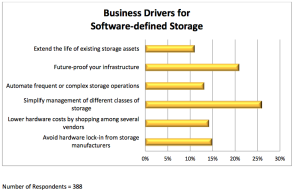
Demand for Software-Defined Storage Is Up: Survey

Software-defined storage (SDS) is helping to simplify management of disparate storage devices while enabling IT administrators to “future-proof” enterprise networks, according to annual survey of the SDS market.
DataCore Software Corp. said it surveyed 388 global IT professionals to identify current enterprise challenges and to gauge the factors driving demand of software-defined storage.
Twenty-six percent of respondents said SDS helps ease management of incongruous storage devices while 21 percent said SDS helps preserve existing infrastructure while enabling future upgrades.
 Others SDS business drivers identified by respondents included: avoiding hardware “lock-in” from storage manufacturers (15 percent); lower hardware costs (14 percent); automating frequent or complex storage operations (13 percent) and; extending the life of existing storage assets (11 percent).
Others SDS business drivers identified by respondents included: avoiding hardware “lock-in” from storage manufacturers (15 percent); lower hardware costs (14 percent); automating frequent or complex storage operations (13 percent) and; extending the life of existing storage assets (11 percent).
The majority of respondents (57 percent) worked for organizations with fewer than 1,000 employees. Twenty percent of respondents were with large companies with more than 5,000 employees. IT administrators for financial services companies accounted for the most survey responses (22 percent).
Respondents identified two key factors complicating their organization’s ability to upgrade its storage infrastructure. The largest was “the plethora of tools” required to manage different storage platforms and devices (41 percent) and the difficulty of migrating to different platforms or platform upgrades (37 percent).
The surveyed found that IT administrators are even more concerned this year about the difficulty inherent in storage diversification than in the past. Another issue is lack of backward compatibility between upgrades and existing storage equipment.
The integration of flash memory storage into datacenters also plays a role in considering software-defined storage. The survey found that a majority of respondents (63 percent) have less than 10 percent of storage capacity assigned to flash solid-state storage
Still, “While we don’t anticipate the relative percentage changing significantly in the near future, it should be noted that almost a quarter of respondents (22 percent) are using flash cache in a shared storage array to support server virtualization projects,” the survey’s authors noted.
As workers grow accustomed to faster response times on commercial websites, IT administrators are faced with the additional challenge of meeting the same application performance expectations within organizations.
Nevertheless, respondents had mixed views about the impact of virtualized server workloads on application performance. Asked how serious an obstacle is performance degradation or the inability to meet performance expectations, 23 percent said it was the most serious obstacle. Yet, nearly a third (32 percent) of respondents viewed it as only “somewhat of an obstacle to virtualization.”
Concluded the survey authors, “Performance slowdowns attributed to storage indirectly accelerate the urgency for software- defined storage.”
Of continuing importance to IT administrators were “both the ability to enable storage capacity expansion without disruption and the improvement of disaster recovery and business continuity practices [which] ranked highest for reasons that organizations deployed storage virtualization software,” the survey found.
Thirty-two percent of respondents ranked disaster recovery and business continuity as most important while 30 percent identified enabling storage capacity expansion without disruption as critical.



























